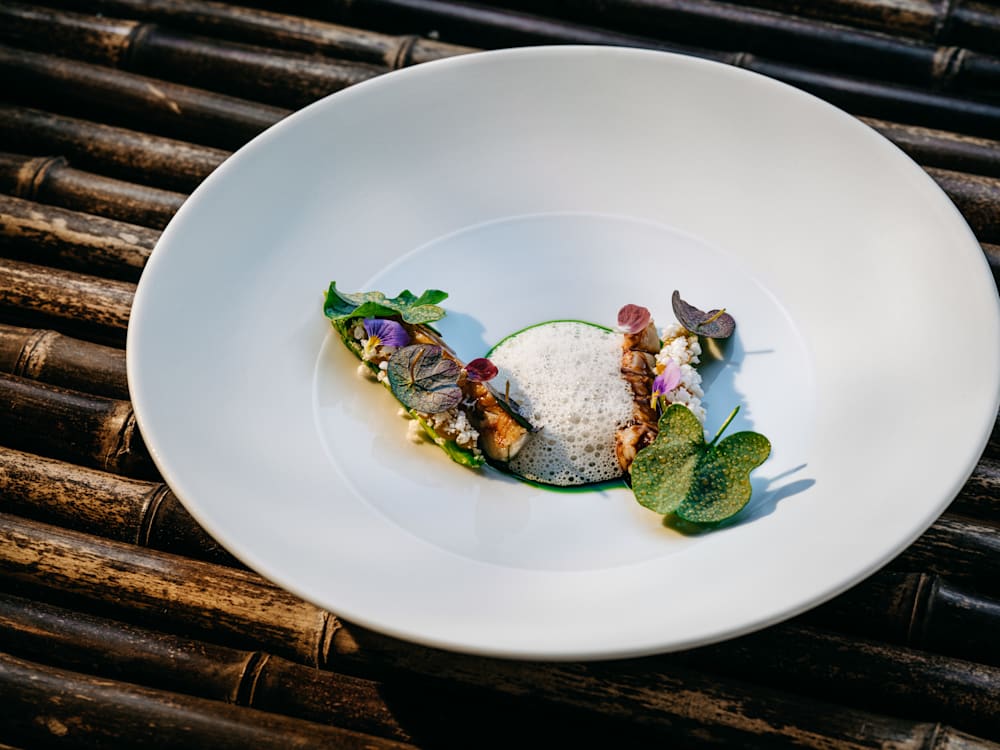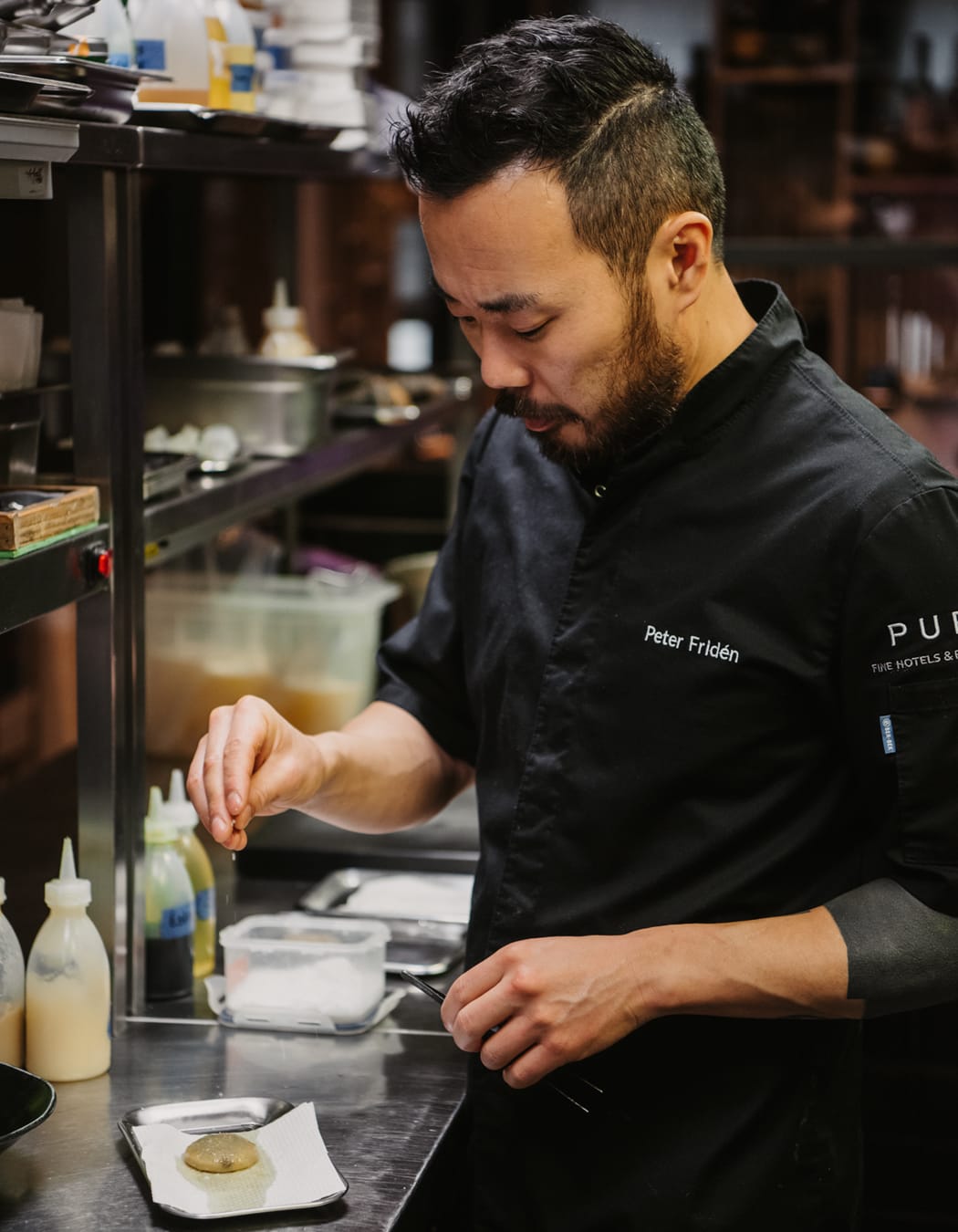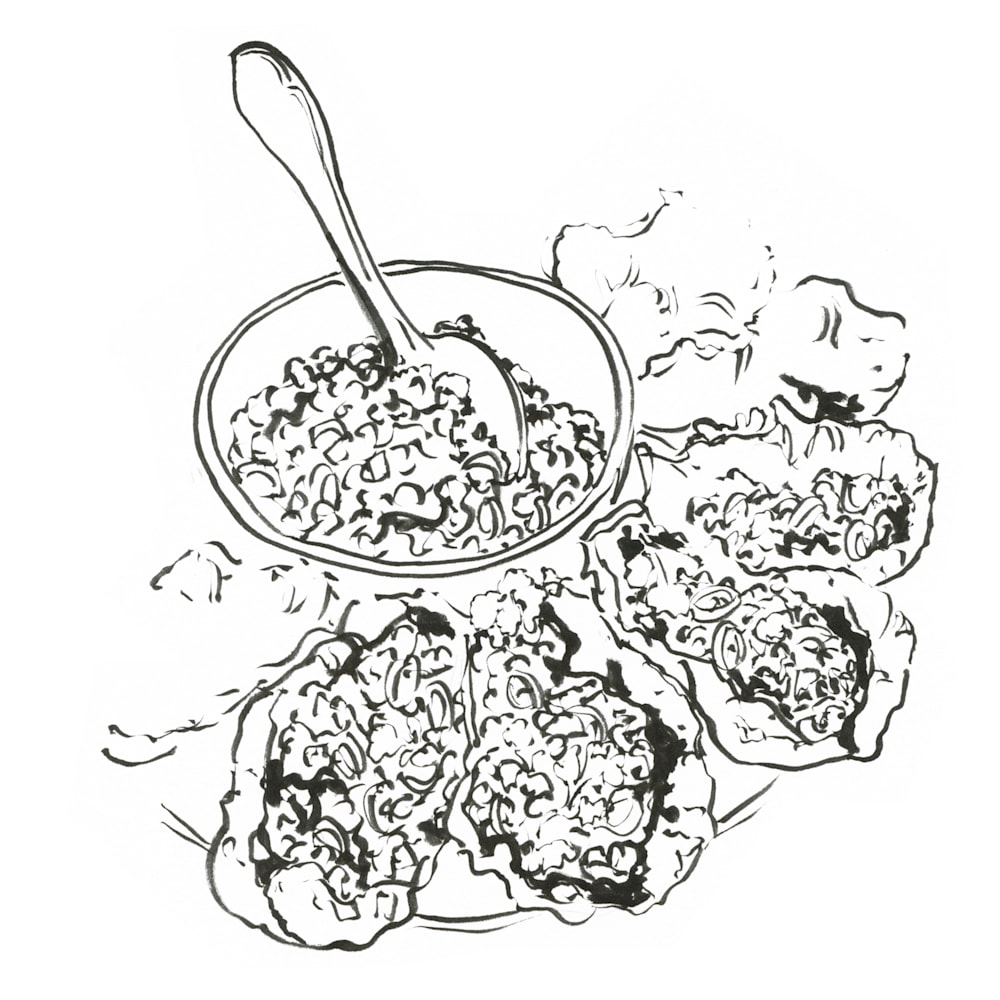Let us introduce you to the world’s most exciting hotel chefs as we guide you through the gourmet getaway spots we’re hungering for…
WHO’S IN THE KITCHEN?
Peter Fridén, head chef at Rhineland retreat Purs Luxury Boutique Hotel, whose menu clocks up global influences like you would air miles. He’s a true international talent: born in South Korea, growing up in Sweden, specialising in French cookery, working in the UK and Germany, and travelling widely in between.
WHAT’S COOKING?
Geographically distant, but conceptually complementary. At Purs’ restaurant, Fridén brings his various worlds together to create New Nordic-Japanese dishes — with a soupçon of indulgent French refinement — which find common ground in their deep connection to nature, fresh clean flavours and the kind of delicate presentation that makes you weep for taking a fork to it (but not for long).
Expect the likes of Norwegian langoustine slick with spruce butter, quail aged in hay with fermented plum and onion miso, and wild-mushroom dumplings in an umami-rich dashi infused with tarragon and Buddha’s hand. Start with a sparkling sake, add a dash of caviar here and there, then sign off with cinnamon-roll petit fours.

RECIPE FOR SUCCESS
Fridén has worked with countless Michelin-star holders — electricity-shunning, fire-cooking pioneer Niklas Ekstedt in Stockholm; Alain Roux at the UK’s lauded Waterside Inn; late legend Heinz Winkler (the youngest chef ever to achieve three Michelin stars) at Bavarian eatery Aschau – and he completed a stint at über cool Soho House Berlin. In the Rhineland, Peter’s previous restaurant at Purs – Yoso – went on to win him his own star.
You were born in South Korea, grew up in Sweden, trained in French cookery and have headed up the kitchens at several German restaurants, including Yoso at Purs. How has each destination influenced and inspired your style of cooking?
In many different ways, I would say. Each position and project has been a platform from which I can improve my skills and learn from my previous mistakes and successes. So I always restart from where I ended, with newfound knowledge.
What’s your favourite restaurant and dish from each of those countries?
If we’re talking about dishes I’ve cooked, I have a very positive memory of a pike-perch I made during my time as sous-chef for Niklas Ekstedt in Sweden. It was tempered on its bone and served with a smoked beurre blanc enriched with nut butter. The dish respected the fish’s natural shape and flavour, making it clear and fresh.
In the UK, at the Waterside Inn, we had a rotisserie where we’d grill a whole pig for our guests – the resulting quality and taste was mind-blowing.
And a good memory from working at chef Heinz Winkler’s restaurant in Germany is the way they made sauces, which changed my perspective of sauces completely and influenced how I make them today.
Axel Vervoordt, the designer behind Purs Hotel, adopted the philosophy of wabi-sabi for its concept, design and more – does this idea extend to the kitchen, and how have you interpreted this in your cookery?
The fundamentals of wabi-sabi and the humble idea of how imperfection can become perfection itself stretches – at least for me – into how we behave as humans. Cooking is then a way to express myself through focusing on natural flavours, tackling the daily challenge of finding clarity in their imperfections, and creating something more refined.
Your speciality is New Nordic-Japanese cuisine. How have you brought these together in your own style? And in what ways do they complement each other?
To put it simply, these influences are all just a bit of who I am. I was adopted from Eastern Asia, grew up in the forests of northern Sweden and I was schooled in French and Scandinavian cuisine. For me, it makes sense to combine these three culinary worlds. The French with its wide spectrum of sauces, the Japanese with its pure flavours, and the Scandinavian with its minimalistic design make for a flavourful mix.
You were formerly head chef at Soho House Berlin and now work in Andernach by the Rhine – how do the city and countryside dining scenes differ?
They differ a lot! Soho is a high-end establishment that focuses on trends and food with a certain cosmopolitan flair. Here, in Rheinland-Pfalz, further southwest, tradition is omnipresent in cooking and dining.
You’ve said you learnt how to cook with your family in Sweden, which has a strong culture of foraging for wild food. Are you skilled in the art of foraging?
I can’t say I’m a skilled forager, far from it. But I am very aware of its practices and keep an eye out for what people are finding on foraging missions.
Where’s your favourite place to travel to? And what’s the best meal you’ve ever had there?
Japan – just go there and eat, it’s not hard to find stuff you’ll like.
What’s the secret recipe to a successful dinner party? Who are your dream guests, what are you cooking them and what’s on the playlist?
Good company and easy comfort food – if you can grill it, do it. Guests that appreciate good food and conversation are always welcome, and Pink Floyd would be spinning in the background, for sure.
What’s your travel style?
If it’s a longer trip, I tend to live cheaply, but eat and shop expensively. For a shorter trip, I prefer to stay by the beach as comfortably as possible.
When you’re taking time off from cooking, where’s your favourite place to unwind in Purs Luxury Boutique Hotel?
When it’s possible – and if it’s empty – I try to sit in bar area to collect my thoughts and feelings. Otherwise the Smokers’ Lounge is a great place for a spontaneous catch-up with a fellow colleague.
What drew you to work at Purs hotel? What do you think makes the place feel so special?
Axel Vervoordt has created a hotel where there’s a very authentic feel throughout, and every detail is highly crafted, evoking feelings and memories.

ANSWERS À LA MINUTE
You can hop to three countries for breakfast, lunch and dinner – where are you going?
Breakfast in Paris, for good coffee, croissants and butter — I admire the French passion for good bread too. I’d have lunch at a hawker stall in Singapore, where the multitude of options are served fast and are crazy good – but really, anywhere renowned for Hainanese chicken and rice. And for dinner I’d stop in Scandinavia, to see how culinary developments have increased over the past year or so and devour chashu ramen with braised pork belly at Japanese diner Misshumasshu. Or I’d do all three in Japan!
If you could redesign plane food, what would you serve?
More Hainanese chicken…
You’ve snuck some minis onto the plane – what cocktail are you making?
Nothing: I’m not a fan of drinking alcohol, especially not on a plane.
Room service – what are you ordering?
A salad.
Which meal instantly transports you home?
Crayfish.
Which dish from your travels do you wish you’d created?
The spicy ramen (which earned a Michelin star) at Bib Gourmand eatery Sōsakumen Kōbō Nakiryū in Tokyo.
What’s your guilty-pleasure holiday treat?
Ben & Jerry’s ice-cream.
What’s your favourite dish on the menu at Purs Kitchen?
Quail, aged in hay for 14 days. The braised and grilled quail leg gets grilled and seasoned with fermented black pepper; and we serve it with fermented watermelon, plum, a dark-miso emulsion made from caramelised onions, foie-gras terrine, umeboshi vinegar, macadamia nuts, a drizzle of quail sauce and sourdough brioche with hay-nut butter.
TIME TO SERVE
Here’s Peter’s easy – and inexpensive – yet delicious recipe for vegan Chinese san choy bao (lettuce wraps) with smoked tofu, ideal as part of a casual dinner party.

San choy bao
Serves four, with two portions each
Prep time minimal
For the tofu
- 100ml hoisin sauce
- 1 lime
- 20ml water
- 240g smoked tofu
For the rest
- 2 romaine lettuce hearts
- 1 red chilli pepper
- 1 spring onion
- A few sprigs of coriander
To prepare
Remove the stalks from the lettuce hearts and wash all the leaves in a sieve. Spin dry and lay out eight ideally shaped leaves on a piece of kitchen paper.
Chop the smoked tofu into small cubes, then cut the lime in half, dividing one half into two wedges and mixing the juice from the other half with the hoisin sauce in a small saucepan.
Slice open the chilli pepper and tap to remove the seeds, cut into fine rings, then thinly slice the spring onion.
Heat the hoisin sauce and lime juice in a small pan, add the tofu and stir slowly until warm.
Pluck the coriander leaves from the sprigs. Place a heaped tablespoon of tofu on each lettuce leaf. Garnish the san choy bao with the spring-onion rings, chilli pepper and coriander. Arrange the stuffed leaves on a platter or bamboo basket, add the two lime wedges and serve.
Bon appetit!
Illustration by Phoebe Rutherford

